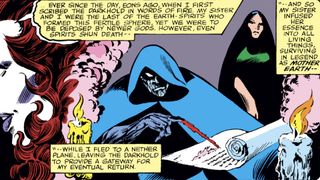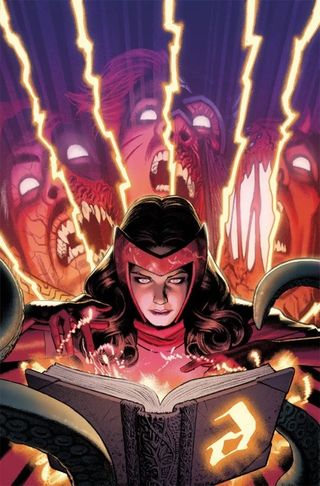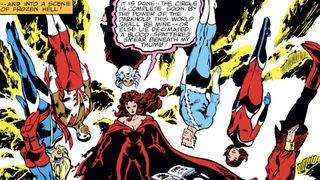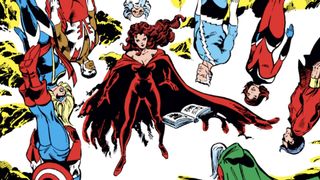WandaVision culminated in Wanda Maximoff seizing the tome of eldritch magic known as the Darkhold, elevating her into the 'Scarlet Witch,' a term the Marvel Cinematic Universe defines as a witch with unlimited magical potential to affect reality.
While there's a lot to be said about WandaVision's potential impact on the MCU going forward, the introduction of the Darkhold seems to establish how Wanda Maximoff - and potentially Agatha Harkness - may fit into Doctor Strange in the Multiverse of Madness.

In Marvel Comics lore, the Darkhold is a tome of evil magical knowledge with direct ties to Wanda's history and her powers - and the sinister undercurrent of manipulation and mayhem that goes along with her magical abilities.
Forged by one of Marvel's Elder Gods, the Darkhold has haunted Wanda and the entire magical environment of the Marvel Universe for most of her Marvel Comics history.
We'll get into how it all works out, and how the Darkhold's comic book history could impact how it and Wanda herself fit into the future of the MCU.
What is the Darkhold?

Sometimes called the 'Book of Sins,' Marvel Comics' Darkhold has an ancient, eldritch history of black magic, chaotic deities, and reality-conquering power. But its true nature is as one of the publisher's most primal magical artifacts, a wealth of sorcery that dates back to the time before the sinking of Atlantis in the Marvel Universe (as does its possible MCU guardian Agatha Harkness, one of Marvel Comics' most ancient magical beings).
Originally bound in iron scrolls, the Darkhold contains the vast, diabolical magical knowledge of the Marvel Comics' chaos deity Chthon.
An Elder God of dark magic who sensed Wanda Maximoff's reality-altering nature as a 'Nexus Being' (a being with ties to the so-called Nexus of Marvel's Multiverse, a place where all realities touch), Chthon gave Wanda a portion of his own chaotic essence at the moment of her birth. That chaotic essence first manifested as Wanda's 'Hex Powers' which caused bad luck to those who she cast her 'Hex' upon, and eventually evolved into a conduit to much darker power and much graver consequences.
After its forging in iron scrolls, the Darkhold survived the collapse of Atlantis and Conan the Barbarian's Hyborian Age (which is part of the Marvel Universe through Marvel's licensed Conan comics) under the stewardship of numerous sorcerers and dark magicians – including Marvel's first canonical vampire Varnae, who was born of the Darkhold's magic (keep that in mind for later).
In the time of Marvel's version of Camelot, the kingdom of King Arthur, the villainous Morgan le Fay bound the scrolls of Chthon into the first true version of the Darkhold – a book containing magic so vile and so dire that Camelot's court magician Merlin, himself a Multiverse-connected 'Nexus Being' like Wanda Maximoff, feared it when it was wielded against him by Morgan's son Modred.

Both Modred and Morgan le Fay later went on to become major villains for Wanda Maximoff (and Morgan le Fay even made the jump to Marvel TV alongside a version of the Darkhold in Hulu's Runaways).
It was Modred kidnapping Wanda to the mysterious magical font Mount Wundagore in Avengers #186, the tale that established Wanda's Chthonic connections and started her on the path to harnessing her mystical abilities.
Later, 1998's Avengers Vol. 3 by Kurt Busiek and George Perez kicked off with a story arc in which Morgan le Fay used Wanda's Chthonic power and reality-altering abilities as a sort of magical battery to remake the entire Marvel Universe into a twisted medieval world of her own whims, where fantasy versions of the Avengers served as her personal guard.
In both instances, Wanda's connection to Chthonic power – and by some extension the magic of the Darkhold – led to her power and will being subverted and manipulated by villains.
How does the Darkhold fit into the Marvel Universe?

After its pages were scattered across the globe in the time of Camelot, the Darkhold became an object of myth, with pages occasionally popping up around the Marvel Universe throughout its history, resulting in the seeding of numerous Chthonic elements and magical beings.
Alongside the aforementioned Varnae, the first vampire (whose name may come from the poem 'Varney the Vampire,' one of the first known pieces of modern vampire fiction), the Darkhold also spawned the curse of lycanthropy in the Marvel Universe.
The story of Marvel's first werewolf has more twists and turns than you might expect, but the TL:DR is, a man named Grigori Russoff came into possession of some pages of the Darkhold, and by extension came into conflict with Dracula (yeah, a version of the fictional Dracula of the Bram Stoker novel, based on the historical Vlad the Impaler). When he was bitten by Dracula's wolf, he became the first true werewolf.
Incidentally, he passed that curse on down his family line (along with a penchant for the Darkhold) until his lycanthropy affected his distant descendant Jack Russell, Marvel's so-called Werewolf by Night. Interestingly, the star of one of Disney Plus's planned MCU streaming shows, Moon Knight, made his debut trying to capture Jack Russell in Werewolf by Night #32.
And speaking of Dracula and Varnae, we have to mention Blade, Marvel's well-known vampire hunter.
Blade debuted in Tomb of Dracula #10, as a kind of superheroic adversary for Marvel's version of the 'King of Vampires.' In the '90s, Blade was often an ally of a team known as the Darkhold Redeemers, who sought to wipe the Darkhold's magic from the Earth. Their adventures and battles with the Darkhold were relayed in the title Darkhold: Pages From the Book of Sins.
Though he originated in the '70s, Blade became a household name in a trilogy of films kicking off in the late '90s that arguably made Marvel Comics movies viable on the big screen and paved the way for '00's X-Men, the first major Marvel superhero movie.
Blade is getting a new MCU movie with Mahershala Ali in the title role – another planned franchise with direct ties to the Darkhold in Marvel lore.
Numerous other Marvel villains have sought the power of the Darkhold over the years. Naturally, Mephisto, Marvel Comics' closest analog to the Biblical devil, has meddled with the magic of the Darkhold in his long existence. And in a recent story, sadistic Spider-Man villain Carnage tapped into the magic of the Darkhold.
And, in the story Secret Empire, Zemo (who returns to the MCU in The Falcon and the Winter Soldier) used the Darkhold to boost the powers of his allies. Perhaps coincidentally (or perhaps not), both Zemo and Wanda are from Sokovia in the MCU.
But maybe most interestingly, the villainous Doctor Doom, a skilled super-scientist and sorcerer who has often tried to seize the power to remake reality in his image, has occasionally turned to the power of the Darkhold.
In the story Avengers: The Children's Crusade, it's revealed that many of Wanda's tragedies – from the time she used dark magic to create her own children, through to Avengers: Disassembled in which she destroyed her own allies, and into House of M which led to Wanda remaking reality itself and nearly wiping out mutantkind – were manipulated by Doom in a bid to reach a final ritual in which he and Wanda, who he had ensorcelled, would wed and Doom would seize her power to change reality.
Of course, that didn't come to pass, but it's perhaps the most egregious example of a villain manipulating Wanda's will and power for their own ends, leading to devastation in her personal life.
This fall, the Darkhold will be at the heart of a series of one-shots in which Wanda Maximoff organizes a team of heroes to combat the power of the evil tome. Oddly enough, Marvel states the story will be something of a flashback, as Wanda Maximoff is currently dead in comic books, the victim of the murder for which her adoptive father will be accused in The Trial of Magneto limited series.
The Darkhold in the MCU

On that note, WandaVision has now introduced a new MCU version of the Darkhold, or as Agatha also calls it in the episode, the Book of the Damned.
The MCU has (maybe?) featured versions of the Darkhold before, with Agents of SHIELD anchoring a prominent storyline around the cursed book, and some separate appearances in Hulu's Runaways, alongside Elizabeth Hurley as Morgan le Fay – though the version of the Darkhold that crossed between those shows doesn't look like the book that appears in WandaVision.
While there is (and may always be) some question about how closely Agents of SHIELD, Runaways, and other pre-Disney Plus Marvel shows fit into the MCU if at all, it's worth noting that Agents of SHIELD established that its version of the Darkhold wasn't derived from Chthon (who hasn't appeared or even been directly referenced in the MCU) but from Doctor Strange's foe Dormammu and his Dark Dimension.
(And of course, now that Loki has opened up a whole Multiverse of 'variants' of known MCU characters and concepts, there may be more than one version of the book, or that the TV shows could connect to the MCU as alt-realities).
Given Wanda's confirmed appearance in the upcoming film Doctor Strange in the Multiverse of Madness, it's possible the Dormammu connection could carry over to the new version of the Darkhold.
When Wanda ascends to the power of the Scarlet Witch Agatha Harkness tells her she has no idea what she's done, and that she'll need Agatha's guidance later on.
Considering the MCU has established that its concept of the 'Scarlet Witch' is a natural magic user with ties to so-called 'Chaos Magic' who will, according to the Darkhold, end the world, it's very possible that using the Darkhold and ascending to the mantle of the Scarlet Witch could unleash Dormammu from the time loop in which Doctor Strange previously trapped him in the MCU.
(An odd side-note, the 'Scarlet Witch' is not a Marvel Comics title, it's just Wanda's codename. The MCU term seems to come from the real-world occult concept of the Scarlet Woman, a human embodiment of an apocalyptic goddess, which was developed by famed occultist Aleister Crowley).
Ominously, WandaVision's final post-credits scene depicts Wanda in her Scarlet Witch form studying the Darkhold while Billy and Tommy, apparently lost when Westview was erased, call for help from an unseen place.
With Wanda now studying the Darkhold, could she become something of a villain in Doctor Strange in the Multiverse of Madness?
The Darkhold has other comic book connections that seem to tie directly into other movie and TV properties Marvel Studios has in the works.
For one thing, Marvel's Black Knight, who will appear in the upcoming Eternals movie, carries the Ebony Blade, another cursed artifact that ties back to the days of Arthurian legend and Camelot. The Ebony Blade was actually forged by Marvel's version of Merlin, who fought the Darkhold in his day. This means Eternals could also feature story elements tying back to the history of the Darkhold.
There are also the previously mentioned connections to Blade, who is getting his own movie, and Moon Knight, who's getting his own TV show, and of course the Fantastic Four, who also have an MCU movie in the works.
The Darkhold's Marvel Comics connections to everything from Wanda Maximoff, to Blade, to Moon Knight, to the Eternals, to the Fantastic Four and Doctor Doom, and beyond could position the Darkhold may become something of an Infinity Gauntlet for the next saga of the MCU, in the way that the Infinity Stones kicked off the stories and powers of many MCU heroes in the 'Infinity Saga.'
The Darkhold features prominently in some of the best Wanda Maximoff/Scarlet Witch stories ever.


